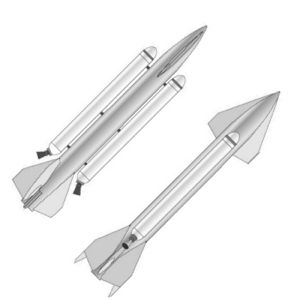
Home - Search - Browse - Alphabetic Index: 0- 1- 2- 3- 4- 5- 6- 7- 8- 9
A- B- C- D- E- F- G- H- I- J- K- L- M- N- O- P- Q- R- S- T- U- V- W- X- Y- Z
R-112
 R-112 Credit: © Mark Wade |
Status: Cancelled 1951. Gross mass: 1,500 kg (3,300 lb). Apogee: 15 km (9 mi).
The R-112 was an advanced medium surface-to-air missile derived from the R-102 (Schmetterling). SKB-5 of NII-88 under Chief Designer Semyon Yevelyevich Rashkov was authorized to begin work on the design in a decree of 14 April 1948. The missile was to be produced in three variants: R-112A, with a self-homing guidance system and a 160 kg warhead; the R-112B, unguided but with a 270 kg warhead; and the R-112S - unguided but powered by a ramjet engine. Subcontractors included: NII-504 MSKhM - target-ranging system; NII-885 MPSS - telemetry and control systems; NII-6 MSKhM - solid propellant booster motors; NII-6 MSKhM - warhead; MV - self-destruct system; and TsAGI MAP - aerodynamic layout.
The draft project for the R-112 was defended before a plenary session of NTS NII-88 on 4 August 1949. The rocket as designed would used two solid propellant boosters. These would burn out 2 to 3 seconds from launch, after which the missile would cruise to the target under the power of a liquid propellant engine. The missile had a total mass of 1500 kg, would reach a speed of 700 m/s, an altitude of 15 km, and a range of 20 km. Accuracy was 25 m at 20 km range. Maximum target speed was 300 m/s.
Aerodynamically the missile was equipped with two fixed wings and two rudders in-line. A launch battery would consist of six trailer-launchers, with one missile per launcher. All six could be fired within 13 seconds. No external guidance was to be provided to the missiles. The draft project consisted of 12 volumes; volume 11 dealt with the R-112S ramjet version. Rashkov was still the overall designer for this variant, but Mikhail Makarovich Bondaryuk of OKB-3 NII-1 TsIAMI was responsible for the integral ramjet and associated aerodynamics. Within NII-88 a half-scale flying prototype of the R-112S had been built. By May 1949 the following models had been delivered for test in the wind tunnels of NII-88 Section 11:
- Model 1, with a diameter of 75 mm, for analysis of the internal ramjet diffuser channel performance.
- Model 2, with a 120 mm in diameter, to study external aerodynamics in a closed wind tunnel.
- Model 3, also 120 mm in diameter, used to verify full-scale aerodynamic effects in an open wind tunnel, as a basis for comparison with model 2.
During boost, the elevons were locked at a 45 degree angle. After burnout and separation of the solids, a 2 metric ton thrust liquid propellant engine by Isayev took over. This burned a mixed synthetic oxidizer and kerosene propellants, a combination that had been recommended for maneuvering rockets.
Section 5, after the cancellation of the R-102, still continued work on the R-112. Furthermore the missile's future seemed assured when the R-112 was chosen over the R-117 in June 1950. Ironically, further work on the R-112 was in turn cancelled on 17 August 1951, when the decision was made to cancel all German-derived surface-to-air missiles in favor of new approaches.
Maximum range: 20 km (12 mi). Boost Propulsion: Solid rocket, 2 x boosters.
Family: surface-to-air. Country: Russia. Agency: Rashkov bureau. Bibliography: 571.
Back to top of page
Home - Search - Browse - Alphabetic Index: 0- 1- 2- 3- 4- 5- 6- 7- 8- 9
A- B- C- D- E- F- G- H- I- J- K- L- M- N- O- P- Q- R- S- T- U- V- W- X- Y- Z
© 1997-2019 Mark Wade - Contact
© / Conditions for Use